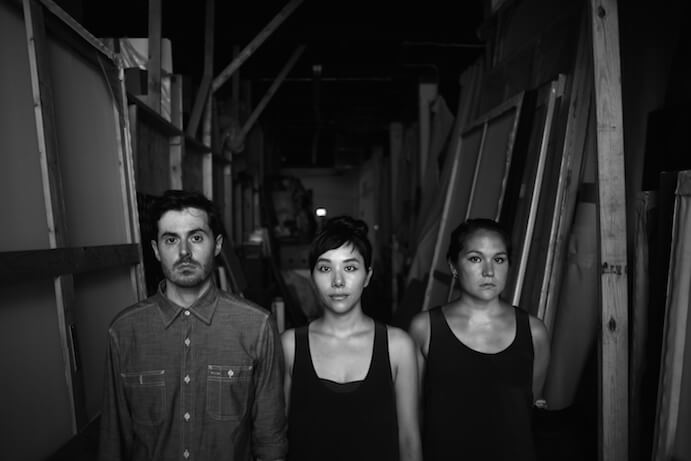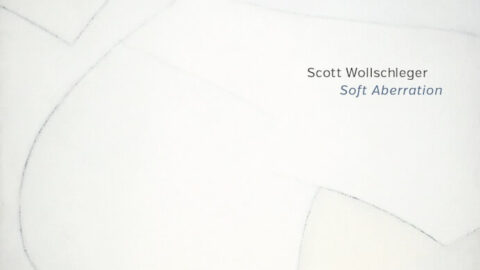New York based composer Scott Wollschleger describes his work, Soft Aberration, in the following manner: “Soft Aberration is a piece about imitation, but rather than sharing identical musical material, I imagined each instrument as a damaged reflective surface, which projects a kind of ‘broken echo’ between the two instruments. In some sense, the piano wants to ‘see itself’ in the viola’s music, and the viola wants the same from the piano. The two struggle with this throughout the piece, and at various times they find a way to ‘see’ each other.”
Included on the composer’s debut portrait recording, which bears the same title as the piece (released October 20, 2017 by New Focus Recordings), this captivating note seems compatible with the album as a complete unit, just as the title lays across the varying works and ties them together under the notion of objects and forms endeavoring to see their reflections within an imperfect mirror. In many ways, this is an album that feels like a single, expansive work, and yet it is a work in which each part also comes across as a whole, like exploring the reflection of the surrounding room in the complex surface of a cut and polished gemstone; each surface reveals a new perspective that cannot be experienced within the room itself, but only through its reflection.
The opening track, entitled Brontal Symmetry, was commissioned by New York based piano trio Longleash, made up of pianist Renate Rohlfing, violinist Pala Garcia, and cellist John Popham. The piece embodies an aspect of Wollschleger’s uniquely individual idiom that the composer describes as “creative repetition in form,” with subtle, driving undulations broken regularly by cascading bursts of activity that descend effervescently before settling again into a churning swamp of low tones from the piano, metallic sighs from the cello, and delicate ricochets from the violin.

Indeed, many of the works on the album vacillate between expansive nebulas probing the composer’s interest in “conceptualizing silence” and lucid periods of mechanistic, rhythmic repetition that invoke a suggestion of self awareness, as though wandering particles of distinct and inherent quality have suddenly coalesced into some new, aggregate form; an organism that has spontaneously emerged from swirling and chaotic silence and realized it can walk or swim or fly through the air, but does so only to explore the revelation of locomotion, without yet having grasped the power it wields to direct its course through the ether. In describing Brontal Symmetry, Anne Lanzilotti may be indirectly referring to this apparent invocation when she suggests the piece is founded upon the “idea that we can create art that is very basic and human by discovering the sensation of an object.”
The album’s title track, Soft Abberation, commissioned and performed by pianist Karl Larson and violist Anne Lanzilotti, hovers more consistently over that plane of formlessness on the verge of taking flight while (as described above) each instrument struggles to see itself in the other.
Bring Something Incomprehensible into This World is a rather fascinating piece for trumpet and voice, commissioned and performed by soprano Corrine Byrne and trumpeter Andy Kozar. Divided into three parts and spread across the remainder of the album, the work showcases Wollschleger’s knack for weaving luscious tapestries out of overlapping timbres within simple and delicate cells of material. The piece exhibits this process on a number of layers, making interchangeable the qualities of language and abstract sound, establishing new, conceptual instruments by combining these contrasting qualities in various ways (occasionally converging in what the composer describes as “dirty unisons”) and through the frequent interjection of space and silence.
As with the other works on the album, this piece represents in many ways both a part and the whole, a sort of musical synecdoche crafted not in concept but by the sounds themselves. This is explained poetically by the epigrammatic, eponymous text, which summarizes Wollschleger’s views on the purpose of art as the “rendering [of] something into existence that is inconceivable before it happens.”
America for solo cello, commissioned and performed by Longleash’s John Popham is a textural work that “reflects upon the desolation of the country.” Anne Lanzilotti compares the piece to another work by conceptual artist Glenn Ligon, called Double America 2, which she encountered at The Broad in Los Angeles. Like Ligon’s sculpture, a neon sign of the word AMERICA with its inversion underneath it, the piece suggests the limitless complexity of meaning and depth that is often overlooked in the idealization of a whole. In Ligon’s piece, the inverted AMERICA flickers unsettlingly, implying a less wholesome foundation than the clean, outstanding, right-side-up AMERICA suggests. Wollschleger’s composition draws out of the solo cello a symphony of sounds, textures and spectral sonorities, similarly alternating between warm solidity and fragile, hostile instability, impossible to summarize in a single sound or gesture.

Finally, White Wall, a two part string quartet commissioned and performed spectacularly by the Mivos Quartet, emerges from whispers and breathy murmurs at first conjuring spirits of Lachenmann and Feldman, before Wollschleger’s distinctive, pulmonary rhythms erect structures around them, echoing the ebb and flow of the preceding works but in an altogether unique space; another beam broken apart by Wollschelger’s prism, the emergence of form out of the white noise to which the title alludes.
In Wollschelger’s work it seems the listener is fully integrated into the creative process. There is no illusion, no curtain to pull aside or opaque, structural tropes to decode that are propped up by dense and overly articulated program notes. Nonetheless, the potential for ever increasing meaning feels limitless. Wollschelger’s stark honesty is approachable but deceptively simple and possessed of many, immeasurable (and some undetectable) dimensions. Rather than falling from above and condescending from some pedestal of intellectual vanity, these magical works rise holistically out of a more primal space and carry the listener with them as their petals unfurl and their flowers bloom over the dark, reflective pool of Wollschleger’s deeply profound imagination.
























